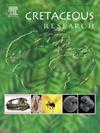约旦塞诺曼—土鲁期碳酸盐岩的综合碳同位素地层学和生物地层学——更新的年龄模型和与阿曼的层序地层对比
IF 1.7
3区 地球科学
Q1 GEOLOGY
引用次数: 0
摘要
基于沿N-S ~ 124 km的4个完整的露头剖面,提出了约旦中西部阿尔卑统至Coniacian Ajlun群的一个新的综合年龄模型。碳同位素曲线与已发表的碳同位素数据相结合,并受到新的和现有的纳米化石和菊石生物地层学的限制。关键的碳同位素事件包括Cenomanian Event 1 (MCE 1)、Cenomanian/Turonian边界的Oceanic缺氧Event 2 (OAE 2)和Turonian mid的Pewsey Event。本研究的发现证实和修正了研究区以往的化学地层学定义,同时也证明了阿基伦群内不同岩石地层单元的形成是同时期的。在阿拉伯板块尺度上,对约旦与阿曼Natih组时间等效地层进行了详细的(三级)层序地层对比。这些相关性有助于评估不同板块构造背景下的地壳运动和构造的相对贡献,因为东北和东部边缘受到与新特提斯洋闭合相关的构造过程的严重影响。在阿曼,与约旦相比,在MCE 1和OAE 2之间的间隔开始增加了住宿空间(约40米)。这表明阿曼的构造前驱事件发生在塞诺曼期中晚期,早于Turonian期主构造期,导致浅水碳酸盐岩沉积终止。相比之下,约旦在很大程度上处于被动的边缘地位。本文章由计算机程序翻译,如有差异,请以英文原文为准。
Integrated carbon isotope stratigraphy and biostratigraphy of Cenomanian to Turonian carbonates from Jordan – An updated age model and sequence stratigraphic correlations with Oman
A new integrated age model of the uppermost Albian to Coniacian Ajlun Group in West-Central Jordan is presented based on four complete outcrop sections along a ∼124 km N–S transect. Carbon isotope curves from this work are integrated with published carbon isotope data and constrained by new and existing nannofossil and ammonite biostratigraphy. Key identified carbon isotope events include the Mid-Cenomanian Event 1 (MCE 1), the Oceanic Anoxic Event 2 (OAE 2) at the Cenomanian/Turonian boundary and the Pewsey Event in the middle Turonian. The findings of this study corroborate and revise previous chemostratigraphic definitions in the study area, while also demonstrating a coeval origin of different lithostratigraphic units within the Ajlun Group. On the Arabian Plate scale, a detailed (3rd order) sequence stratigraphic correlation is made between Jordan and time-equivalent strata from the well-studied Natih Formation in Oman. These correlations help to evaluate the relative contributions of eustasy and tectonics on different plate tectonic settings, since the northeastern and eastern margins were heavily influenced by tectonic processes associated with the closure of the Neo-Tethys Ocean. In Oman, the creation of increased accommodation space (ca. 40 m) is observed relative to Jordan commencing in the interval between the MCE 1 and OAE 2. This suggests the onset of tectonic precursor events in Oman during the middle to late Cenomanian interval before the main tectonic phase in the Turonian, resulting in the termination of shallow water carbonate deposition. In contrast, Jordan remained in a largely passive margin setting.
求助全文
通过发布文献求助,成功后即可免费获取论文全文。
去求助
来源期刊

Cretaceous Research
地学-地质学
CiteScore
4.10
自引率
19.00%
发文量
235
审稿时长
12 weeks
期刊介绍:
Cretaceous Research provides a forum for the rapid publication of research on all aspects of the Cretaceous Period, including its boundaries with the Jurassic and Palaeogene. Authoritative papers reporting detailed investigations of Cretaceous stratigraphy and palaeontology, studies of regional geology, and reviews of recently published books are complemented by short communications of significant new findings.
Papers submitted to Cretaceous Research should place the research in a broad context, with emphasis placed towards our better understanding of the Cretaceous, that are therefore of interest to the diverse, international readership of the journal. Full length papers that focus solely on a local theme or area will not be accepted for publication; authors of short communications are encouraged to discuss how their findings are of relevance to the Cretaceous on a broad scale.
Research Areas include:
• Regional geology
• Stratigraphy and palaeontology
• Palaeobiology
• Palaeobiogeography
• Palaeoceanography
• Palaeoclimatology
• Evolutionary Palaeoecology
• Geochronology
• Global events.
 求助内容:
求助内容: 应助结果提醒方式:
应助结果提醒方式:


